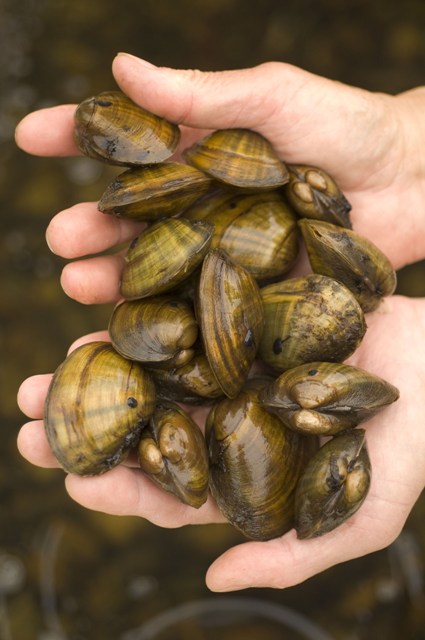Mussels, Mussels Everywhere
August 8, 2012
Photo provided.
– Contributed by Pam Otto
Local creek is safe haven for endangered waterway species
Every Friday from June to August, the kids enrolled in Summer Nature Camp at the St. Charles Park District take part in … drumroll … cue the trumpets … Creek Day!
A summer tradition dating back to when nature camp began in the 1990s, Creek Day is like a mini-Christmas, something kids anticipate all week long. It’s a time to pull on the shorts, put on the old tennies, wade into Ferson Creek and chase after fish, frogs and other neat stuff.
With all that fun to be had, it’s a shame Creek Day is only for kids.
Well, guess what?
As participants in a recent Learn from the Expert class can attest, Creek Day can be for grown-ups, too.
On July 28, we got to hang out with Jessi DeMartini, a good friend who also happens to be a stream ecologist with the Forest Preserve District of DuPage County. Jessi introduced us to the wild and wonderful world of freshwater mussels, first with an hour or so of classroom instruction and then in the creek.
Just like kids on Creek Day, we eagerly headed to LeRoy Oakes Forest Preserve, donned our wading gear and made our way into Ferson Creek. It didn’t take long for our eyes to become accustomed to peering through the water’s reflective surface, and only a few minutes more to start distinguishing the shapes and forms of various underwater residents. Crayfish (the subject of September’s Learn From the Experts class) shot between rocks, propelling themselves backward with a quick flex of their strong abdomens and broad tails. Young largemouth and smallmouth bass were all around, keeping their noses pointed upstream except for when they darted out of our way.
And then we saw them.
Mussels.
Everywhere.
In spite of the drought, or more likely because of it, freshwater mussels lay scattered across the creek’s bottom. Some species, such as spikes (classified as threatened in Illinois) sat atop the substrate, looking much like rocks. Others, such as the hefty plain pocketbooks, were buried so deep in the sand and gravel that only their siphons – two small, fringed openings for taking water in and letting water out – were visible.
We also found giant floaters, paper pondshells and ellipses, which are remarkable not only for their distinctive elliptical shells marked with green stripes but because they are becoming increasingly uncommon in Illinois.
Luck was with us as we headed upstream and spotted a bright orange blob. Looking at first like a discarded wad of gum, the colorful lump was actually the foot of an elktoe, another local species.
One of the great things about mussels, and probably the main reason I was first attracted to them, is their descriptive yet quaint-sounding common names. The elktoe does indeed look like half a hoof of an elk (and not to be confused with the pigtoe, deertoe or fawnsfoot, other species that are present in Illinois). Other fun names include the pistolcase, spectaclecase and monkeyface, all of which accurately describe these species’ shapes and markings. And you don’t have to think too hard to imagine the calamity that must have preceded the naming of the white heelsplitter, a large species with a sharp projection along the back of its shell.
Freshwater mussels also are notable for their fascinating life cycles. Unable, for a variety of reasons, to meet up physically, mussels are completely dependent on their environment for reproduction.
Males release sperm into the water, which is then carried by currents to downstream females. With any luck, some fertilization occurs, and the moms-to-be store their young, called glochidia, in their gills.
That’s when things start to get really interesting. Not noted for their mobility, female mussels nonetheless must disperse their offspring far and wide. What to do, what to do …
It’s fish to the rescue! Female mussels use a variety of attractants, including fleshy “lures” that look like minnows, to bring fish close. Then, at just the right moment, using senses only mussels have, the female lets loose with a stream of glochidia. The little mussels, microscopic at this stage, latch onto the fish’s gills or fins (locations vary by mussel species) and hitch a ride, releasing themselves anywhere between one and 25 weeks later, after their shells have fully formed.
The mussels we found that day in the creek were living, breathing proof that such a complex life cycle really can yield results. In fact, left to their own devices, the mussels and their fish hosts would be just fine. It’s when human impact, in the form of pollutants, siltation and blunt-force trauma (in the form of crushing hooves of stream-crossing horses) is factored in that the mussel picture gets decidedly more complicated.
Freshwater mussels are considered the most endangered group of animals in North America. Of our almost 300 species, 75 percent are listed as state or federally endangered, threatened, of special concern or already extinct.
Which is all the more reason to get out and see them. Forget having to stand in lines at the zoo to see the endangered snow leopard or black rhino. All you need to see the state-threatened spike and its mussel compatriots are sharp eyes, shorts and an old pair of tennis shoes. Because when you’re an adult, any day can be Creek Day.
Pam Otto is the manager of nature programs and interpretive services for the St. Charles Park District. She can be reached at 630-513-4346 or potto@stcparks.org.







